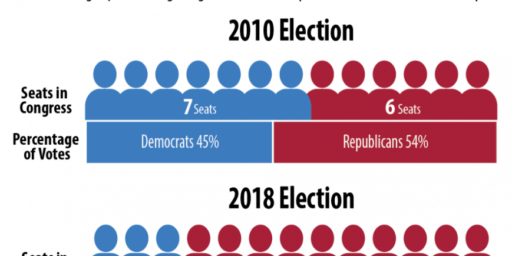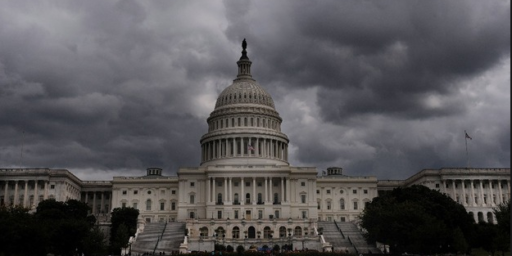The Gerrymandering Myth
John Friedman and Richard Holden, two Harvard graduate students, have a fascinating piece in TNR highlighting the findings of a recent paper they wrote demonstrating that, contra conventional wisdom, gerrymandered congressional districts contribute very little to high incumbent re-election rates when other factors are controlled.
For instance, there’s a lot more money in politics than in the past; and incumbents usually have greater fundraising ability than challengers. A more polarized electorate can also increase incumbent reelection rates, since there are fewer swing voters for a potential challenger to persuade. Growing media penetration in the post-World War II period provided incumbents with free advertising, further bolstering their prospects. And all of these effects are magnified when more qualified challengers choose not to run against incumbents benefiting from these factors.
How can we determine whether gerrymandering is the culprit, especially since any number of reasons could account for the increase in the incumbent reelection rate? The key is that redistricting usually happens only once each decade (at least until the recent controversy in Texas). Other factors, such as money or electoral polarization, tend to change more smoothly over time. One can tease these factors apart with a “regression discontinuity” approach, separating the changes over time into smooth year-on-year increases and jumps at the time of gerrymandering.
For instance, consider the fate of incumbents over the past decade or so. Though fewer than 2 percent of incumbents were defeated in 2002–the election immediately following redistricting–the rate was just as low in 1998, 2000, and 2004. The redistricting before the 2002 election does not seem to have affected incumbents at all. On the other hand, incumbents suffered more than twice that number of defeats in each election between 1992 and 1996, exactly the years when the gerrymandering before 1992 should have been most effective. What’s more, these years were far worse for sitting congressmen than those just before the 1991 gerrymander, in which incumbents fared almost as well as they do today.
Regardless, they argue there are still plenty of reasons to be wary.
So, is gerrymandering an innocuous practice? No. Though it has not caused the rise in incumbent reelection rates, gerrymandering has severely restricted the representation of political minorities in many states. A few particularly stark examples are Florida, Pennsylvania, and Ohio–three states that were evenly split between the parties in the 2000 and 2004 presidential elections, but whose combined congressional delegations comprise 42 Republicans and only 20 Democrats. Democrats play the game almost as well in Massachusetts and Maryland, where Republicans (who make up nearly 40 percent of both states’ populations) account for just 1 of 19 House members.
Of course, those results are only problematic if the distribution of Democrats and Republicans is relatively even geographically. Even a slight statewide majority could translate into a blowout in winner-take-all districts if each district mirrors the state.






I agree that gerrymandering isn’t the only factor in incumbent return, but I am not convinced to dismiss it as lightly as these people.
As an example, they raise the question of polarization reducing the number of swing voters available to be persuaded as an potential alternative. But in effect, that is what we are talking about in gerrymandering. At one time, I lived and voted in a congressional district that returned 90%+ votes for the republican candidate. The democratic legislature had conceded a seat and essentially put all the republicans in the area together into one district. Once a republican was elected, nothing short of the live boy or dead girl in his bed would get him out other than his own decision. Current gerrymandering is generally less blatant (and thus more risky). Rather than trying to put 90+% districts of the opposition together, they aim for 55% districts for the side with the legislative votes but 66+% for the side without the legislative votes in a few districts. This turns a state that is about 60% republican into one that can reliably return a little more than 60% republicans to congress.
An alternative to this is to look at the ungerrymandered states. If you look at senate elections over the last 40 years (roughly the rise of modern conservatism sparked by Goldwater’s defeat by Johnson), two things jump out. Incumbents won at a rate of 88.3%. Secondly, the win rate was essentially constant across the parties and presidential vs non-presidential elections (slightly lower re-election of senators in presidential years). The change from 68 democratic senators at this time 40 years ago to 45 democratic senators today (I lumped independents in with the party they organized with) comes in filling the open seats. Republicans won open seats at a rate of 57% to 43%. The limited number of open seats is what did more for slowing down the transition from democrat to republican. In short, regardless of party, incumbents won reelection at a very high rate (88%), but open seats trended towards the republicans (more in the states that voted republican for president, but even in states voting democrat for president).
So I agree that gerrymandering isn’t the only issue, but it sure is a major one.